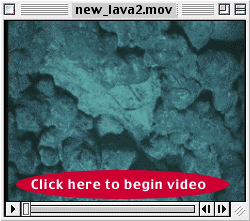|
|
TODAY'S WEATHER
Click here to watch a video on a new lava flow.
April 5, 2000 By Dr. Dan Fornari and Julia Getsiv Morning dawned with striking colors, and then it turned bright and hot, as it has for the past several days here in the tropical Pacific. Since yesterday afternoon, we have been towing Argo II over specific ocean bottom features that we picked out from the DSL-120 sonar images and that we think will help us in our search for recently erupted lava flows. These past few days have been exciting, but also tiring and occasionally frustrating. As a marine geologist, one of the things I dream about is being able to pull the plug on the ocean bathtub so that the water could drain out and we can actually “see” all the seafloor. That would be grand! We are towing Argo II at about 0.5 knot (a speed of about 15 meters per minute), so we don’t get to look at the same spot on the seafloor for very long. All the scientists’ eyes are trained on the video monitors in the Control Van so that we don't miss anything. One of the striking differences between the 9-10°N area (Survey Area #1 on this expedition) and where we are now at 3° 20’N is the morphology (or shape) of the lava flows. At 9-10°N, much of the seafloor is covered by lobate and sheet lavas; here, the lavas are mostly pillowed (see today’s slide show for examples of different lava morphology). We are looking for a lava flow that we believe was erupted about 4 years ago, so it should be younger than the other lavas around it. As you might guess, this is hard, not only because many of the flows look very similar, but also because there may be some sediment on the new flow that would mask its shiny, glassy outer crust. Last night, Maya Tolstoy’s watch saw some glimpses of a darker-colored lava flow that had definitely flowed over the top of sediment-covered lavas. Unfortunately, they did not get a very good look at it so could not tell if it was really young looking or not. During the day, there were lots of discussions among the scientists and students about what Maya’s watch had seen, and whether it might be the 4 year old lava. Dan Scheirer, Paul Johnson, Gregg Kurras, Julia Getsiv and Scott White worked hard to finish maps of the area where the black lava was observed. They used the sonar data we collected a few days ago and the Argo II data collected last night (see a slide show for some great maps that show how we are comparing and analyzing the different data). Tonight, we are heading back to that same area to do a more careful survey with Argo II. We will tow it slower, only about 0.25 knot, so that we can look at each piece of seafloor longer. We will be trying to map where there are fissures (cracks) and whether they have any young lava in them. Check tomorrow’s daily update to see if we have found a young lava flow!
|
|||||||||||||||||||||||||||||||||||||||||||||||||||||||||||||||||||||||||||||||||||||||||||||||||||||||||||||||||||||||||||||||||||||||||||||||||||||||||||||||||||
© 2010 Dive and Discover™. Dive and Discover™ is a registered trademark of
Woods
Hole Oceanographic Institution




